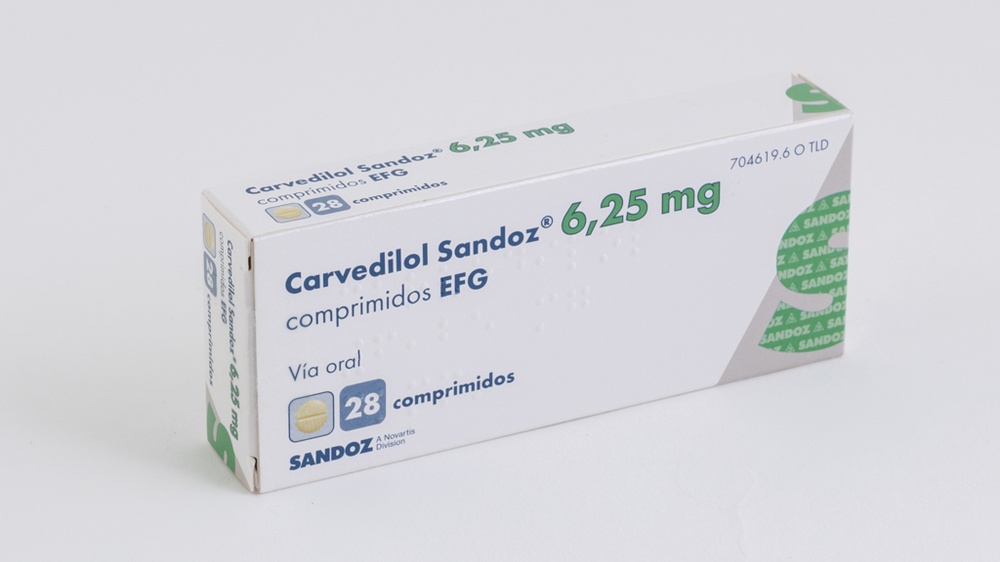

CARVEDILOL SANDOZ 6,25 mg COMPRIMIDOS

Pergunte a um médico sobre a prescrição de CARVEDILOL SANDOZ 6,25 mg COMPRIMIDOS

Como usar CARVEDILOL SANDOZ 6,25 mg COMPRIMIDOS
Introdução
Prospecto: informação para o utilizador
Carvedilol Sandoz 6,25 mg comprimidos EFG
Carvedilol Sandoz 25 mg comprimidos EFG
carvedilol
Leia todo o prospecto detenidamente antes de começar a tomar este medicamento,porque contém informações importantes para si.
- Conserva este prospecto, porque pode ter que voltar a lê-lo.
- Se tiver alguma dúvida, consulte o seu médico ou farmacêutico.
- Este medicamento foi-lhe prescrito apenas para si, e não deve dá-lo a outras pessoas, mesmo que tenham os mesmos sintomas que si, porque pode prejudicá-las.
- Se experimentar efeitos adversos, consulte o seu médico ou farmacêutico, mesmo que se trate de efeitos adversos que não aparecem neste prospecto. Ver secção 4.
Conteúdo do prospecto
- O que é Carvedilol Sandoz e para que é utilizado
- O que necessita de saber antes de começar a tomar Carvedilol Sandoz
- Como tomar Carvedilol Sandoz
- Posíveis efeitos adversos
- Conservação de Carvedilol Sandoz
- Conteúdo do envase e informação adicional
1. O que é Carvedilol Sandoz e para que é utilizado
Carvedilol Sandoz contém carvedilol como princípio ativo, que pertence a um grupo de medicamentos conhecidos como bloqueantes dos receptores alfa e beta. Carvedilol tem propriedades antioxidantes, anti-hipertensivas (diminuição da tensão arterial), vasodilatadoras e antianginosas. Além disso, diminui o gasto cardíaco e tem efeitos favoráveis sobre a circulação sanguínea a nível do coração. Carvedilol está indicado no tratamento de:
- Insuficiência cardíaca congestiva sintomática (o coração perdeu parte da capacidade para bombear sangue) de moderada a grave, de origem isquémica ou não isquémica, além do tratamento padrão (como inibidores da ECA e diuréticos com ou sem digitálicos).
- Hipertensão essencial (tensão arterial elevada).
- Cardiopatia isquémica (chega pouca sangue e oxigénio ao coração)
Nota sobre o uso em insuficiência cardíaca crónica:
- O tratamento com carvedilol apenas pode ser iniciado se o paciente foi estabilizado com um tratamento básico convencional para a insuficiência cardíaca, ou seja, a dose deste tratamento padrão existente deve ter permanecido estável durante pelo menos quatro semanas antes de iniciar o tratamento com carvedilol.
2. O que necessita de saber antes de começar a tomar Carvedilol Sandoz
Não tome Carvedilol Sandoz:
- Se é alérgico a carvedilol ou a algum dos outros componentes deste medicamento (incluídos na secção 6).
- Se padece insuficiência cardíaca descompensada de classe IV (NYHA) (incapacidade do coração para realizar a sua função de bombear ante a atividade física e em repouso).
- Se padece doença pulmonar obstructiva crónica (DPOC), com os brônquios obstruídos (dificuldade para respirar).
- Se o seu fígado não funciona bem (alterações do fígado).
- Se padece asma brônquica.
- Se sofre uma doença do coração que consiste em um bloqueio auriculoventricular de segundo e terceiro grau (a menos que se lhe tenha implantado um marcapasso permanente).
- Se o seu coração bate lento (menos de 50 batimentos do coração por minuto).
- Em caso de falha do coração (ou choque, estado em que o coração foi tão danificado que é incapaz de fornecer sangue suficiente aos órgãos do corpo).
- Em caso de doença do coração que consiste em bloqueio do nódulo sino-auricular.
- Em caso de tensão arterial muito baixa (pressão sistólica de menos de 85 mmHg).
Quando se administra carvedilol ao mesmo tempo que certos medicamentos como a adrenalina (também epinefrina) para tratar reações alérgicas (anafilácticas) requer precaução especial.
É possível que respondam menos a estes. Informe o seu médico imediatamente se padece estas doenças ou circunstâncias que as acompanham, porque se devem ter em conta antes ou durante o tratamento.
Sintomas de abstinência (síndrome de abstinência)
O tratamento com carvedilol não deve ser interrompido repentinamente. Isto é especialmente verdadeiro em pacientes com doenças cardíacas devido à redução do fluxo sanguíneo para as artérias coronárias. Em vez disso, a dose deve ser reduzida gradualmente durante um período de 2 semanas.
Advertências e precauções
Consulte o seu médico ou farmacêutico antes de começar a tomar Carvedilol Sandoz.
Informe o seu médico se tiver alguma doença das citadas abaixo:
- Se apresenta alguma doença pulmonar.
- Se padece diabetes (aumento de açúcar no sangue).
- Se apresenta uma doença do coração.
- Se toma outros medicamentos para o coração, especialmente se está tomando algum dos seguintes medicamentos deve informar o seu médico: digitálicos (aumentam a força do batimento do coração), diuréticos (aumentam a quantidade de urina), inibidor da ECA (medicamento anti-hipertensivo), antagonistas do cálcio (medicamento anti-hipertensivo) e antiarrítmicos (atuam sobre o ritmo do coração).
- Se tiver algum problema de tireoide.
- Se é alérgico e recebe algum tratamento para a sua alergia.
- Se tiver problemas de circulação ou fenómeno de Raynaud.
- Se tiver programada uma intervenção cirúrgica, informe o seu médico de que está em tratamento com carvedilol.
- Se padece uma doença chamada feocromocitoma.
- Se tiver psoríase (doença da pele).
- Se tiver angina de Prinzmetal (dor no peito que começa durante o descanso sem causas óbvias).
- Se vai submeter-se a uma operação com anestesia. Deve informar o seu médico responsável pela anestesia.
- Se utiliza lentes de contacto. Carvedilol pode reduzir a produção de lágrimas.
- Se padece reações adversas cutâneas graves (p. ex., necrólise epidérmica tóxica, síndrome de Stevens-Johnson).
Como ocorre com todos os medicamentos com atividade beta-bloqueante, não deve interromper o tratamento com carvedilol de forma brusca. A dose se deve reduzir gradualmente segundo as indicações do seu médico.
Uso em desportistas
Informa-se os desportistas que este medicamento contém um componente que pode estabelecer um resultado analítico no controlo de dopagem como positivo.
Crianças e adolescentes
Não se recomenda o uso de carvedilol em crianças e adolescentes menores de 18 anos devido a que os dados de segurança e eficácia são insuficientes.
Idade avançada
Os pacientes de idade avançada podem ser mais sensíveis ao carvedilol e devem ser controlados mais cuidadosamente.
Outros medicamentos e Carvedilol Sandoz
Informe o seu médico ou farmacêutico se está utilizando, utilizou recentemente ou pudesse ter que utilizar qualquer outro medicamento, mesmo os adquiridos sem receita médica.
Isso é extremamente importante, porque ao tomar mais de um medicamento ao mesmo tempo pode aumentar ou diminuir o seu efeito. Portanto, não deve tomar carvedilol com qualquer outro medicamento, a menos que se lhe indique o seu médico. Tenha em conta que estas instruções podem ser também de aplicação a medicamentos que se tenham utilizado antes ou se possam utilizar depois.
Informe o seu médico se está tomando algum dos seguintes medicamentos:
- Fluoxetina e paroxetina (medicamentos para a depressão).
- Ciclosporina e tacrolimus (medicamentos utilizados para evitar os rejeições nos transplantes).
- Digoxina, verapamilo, diltiazem e medicamentos antiarrítmicos (medicamentos utilizados para tratar problemas do coração e da tensão arterial).
- Amiodarona (medicamento utilizado para tratar certos problemas do coração).
- Determinados analgésicos do tipo da aspirina e ibuprofeno (AINE).
- Outros medicamentos para a tensão, barbitúricos, fenotiazinas, antidepressivos tricíclicos, agentes vasodilatadores e álcool.
- Medicamentos para a diabetes (incluída a insulina e os antidiabéticos orais).
- Clonidina (medicamento utilizado para controlar a tensão arterial ou a enxaqueca).
- Dihidropiridinas (medicamentos utilizados para tratar a pressão arterial alta ou a angina de peito).
- Rifampicina, (medicamento para tratar infecções).
- Cimetidina (medicamento para tratar problemas gástricos).
- Indutores ou inibidores do metabolismo hepático (medicamentos que modificam a eliminação de outros medicamentos do organismo).
- Inibidores da monoaminooxidase (medicamentos para a depressão).
- Broncodilatadores β-agonistas (medicamentos que se usam para melhorar a capacidade respiratória, como por exemplo na asma).
- Adrenalina/epinefrina (utilizada para tratar reações alérgicas graves).
- Outros medicamentos anti-hipertensivos (por exemplo, reserpina, guanetidina, alfa-metildopa, guanfacina, alfa-bloqueantes ou preparados nitro).
Toma de Carvedilol Sandoz com alimentos, bebidas e álcool
Deve evitar tomar carvedilol simultaneamente ou imediatamente após tomar pomelo ou sumo de pomelo. O pomelo ou sumo de pomelo podem dar lugar a um aumento de carvedilol no sangue e causar efeitos adversos imprevisíveis. Também se deve evitar o consumo excessivo e simultâneo ou pontual de álcool porque o álcool influencia o efeito de carvedilol.
O seu médico ou farmacêutico informá-lo-á sobre as refeições com as quais é recomendável que tome carvedilol.
Gravidez e amamentação
Se está grávida ou em período de amamentação, acredita que possa estar grávida ou tem intenção de engravidar, consulte o seu médico ou farmacêutico antes de utilizar este medicamento.
Não se recomenda o uso de carvedilol durante a gravidez e a amamentação
Carvedilol pode provocar a morte do feto dentro do útero, assim como partos prematuros. Além disso, podem produzir-se efeitos adversos no feto e no recém-nascido. Após o nascimento, o recém-nascido tem um maior risco de sofrer problemas no coração e nos pulmões.
Devido a que carvedilol se excreta pelo leite materno, por isso não se recomenda a sua administração durante a amamentação.
Condução e uso de máquinas
Às vezes carvedilol pode dificultar a capacidade para conduzir ou para manipular máquinas. Isto sucede especialmente quando se começa ou se muda o tratamento e quando se toma conjuntamente com álcool.
Carvedilol Sandoz contém lactose
Se o seu médico lhe indicou que padece uma intolerância a certos açúcares, consulte com ele antes de tomar este medicamento.
3. Como tomar Carvedilol Sandoz
Siga exactamente as instruções de administração deste medicamento indicadas pelo seu médico ou farmacêutico. Em caso de dúvida, consulte de novo o seu médico ou farmacêutico.
A dose normal é:
Hipertensão essencial
Adultos
Via oral. A dose de início recomendada é de 12,5 mg uma vez ao dia durante os dois primeiros dias, A seguir, a dose recomendada é de 25 mg uma vez ao dia. Se for necessário, depois o seu médico pode aumentar gradualmente a dose que recebe (a intervalos de pelo menos duas semanas) até 50 mg uma vez ao dia ou em duas vezes ao dia de 25 mg cada uma.
Idade avançada
Via oral. A dose recomendada para iniciar o tratamento é de 12,5 mg uma vez ao dia, que proporcionou um controlo satisfatório em alguns pacientes. Se a resposta não for a adequada, o seu médico ajustará a dose (a intervalos de pelo menos duas semanas).
Cardiopatia isquémica
Adultos
Via oral. A dose recomendada para iniciar o tratamento é de 12,5 mg duas vezes ao dia (no total 25 mg ao dia) durante os dois primeiros dias. A seguir, a dose recomendada é de 25 mg duas vezes ao dia (no total 50 mg ao dia). Se for necessário, o seu médico pode aumentar a dose que recebe (a intervalos de pelo menos duas semanas) até 50 mg duas vezes ao dia (um total de 100 mg/dia).
Idade avançada
Via oral. A dose máxima recomendada para pacientes de idade avançada é de 50 mg administrados em doses divididas (duas vezes ao dia).
Insuficiência cardíaca congestiva sintomática
Adultos e idade avançada
Via oral. O seu médico indicar-lhe-á de forma individual a dose que deve tomar, vigiando-o durante o ajuste às doses mais altas.
Em caso de estar a tomar outros medicamentos para doenças do coração (digitálicos) ou do controlo da tensão arterial (diuréticos e/ou inibidores da ECA) e antes de iniciar o tratamento com carvedilol, o seu médico ajustará a quantidade de medicamentos deste tipo que deve tomar.
Em qualquer caso, a dose recomendada para o início do tratamento com carvedilol no tratamento da insuficiência cardíaca congestiva sintomática é de 3,12 mg duas vezes ao dia (no total 6,25 mg ao dia) durante duas semanas. Se tolerar bem esta dose, pode aumentar-se posteriormente (a intervalos de pelo menos duas semanas) até 6,25 mg duas vezes ao dia (no total 12,5 mg ao dia).
O seu médico poderá prescrever-lhe posteriormente (passadas duas semanas pelo menos) doses mais altas de carvedilol.
Se você pesa menos de 85 kg, a dose máxima recomendada é de 25 mg duas vezes ao dia (no total 50 mg ao dia). Se o seu peso for superior a 85 kg, a dose máxima recomendada é de 50 mg duas vezes ao dia (100 mg ao dia).
O seu médico indicar-lhe-á a duração do seu tratamento com carvedilol.
Como regra geral, independentemente da sua doença, a retirada de carvedilol deve ser feita pouco a pouco ao longo de alguns dias, ou bem reduzir a dose a metade cada três dias.
Uso em crianças e adolescentes
Não se recomenda o uso de carvedilol em crianças e adolescentes menores de 18 anos, porque não existem dados suficientes sobre segurança e eficácia.
Normas para a correcta administração
Os comprimidos devem ser engolidos com líquido suficiente, preferencialmente com um copo de água.
Se padece insuficiência cardíaca congestiva (o seu coração perdeu um pouco da capacidade para bombear a sangue e pode produzir dificuldade para respirar, debilidade e acumulação de líquidos), deve tomar carvedilol enquanto come, para assim evitar a sensação de mareio ao levantar-se.
Lembre-se de tomar o seu medicamento.
Se tomar mais Carvedilol Sandoz do que deve
Em caso de sobredose ou ingestão acidental, consulte imediatamente o seu médico ou farmacêutico ou ligue para o Serviço de Informação Toxicológica, telefone: 91 562 04 20, indicando o medicamento e a quantidade ingerida.
Se esquecer de tomar Carvedilol Sandoz
Não tome uma dose dupla para compensar as doses esquecidas.
Se interromper o tratamento com Carvedilol Sandoz
O tratamento com carvedilol não deve ser interrompido bruscamente, especialmente se você sofre cardiopatia isquémica, doença que causa que o coração não bombeie bem a sangue. O seu médico irá reduzir a dose pouco a pouco durante alguns dias até que deixe de tomar carvedilol por completo.
Se tiver alguma outra dúvida sobre o uso deste medicamento, pergunte ao seu médico ou farmacêutico.
4. Efeitos adversos possíveis
Tal como todos os medicamentos, este medicamento pode produzir efeitos adversos, embora nem todas as pessoas os sofram.
As frequências dos efeitos adversos foram enumeradas abaixo de acordo com as seguintes definições:
Muito frequentes (podem afetar mais de 1 de cada 10 doentes)
Frequentes (podem afetar até 1 de cada 10 doentes)
Pouco frequentes (podem afetar até 1 de cada 100 doentes)
Raros (podem afetar até 1 de cada 1.000 doentes)
Muito raros (podem afetar até 1 de cada 10.000 doentes)
Frequência não conhecida (não pode ser estimada a partir dos dados disponíveis)
Os efeitos adversos que foram observados são os seguintes:
Infecções e infestações
Frequentes: Bronquite, pneumonia, infecções das vias respiratórias superiores, infecções das vias urinárias.
Trastornos do sistema nervoso
Muito frequentes: Dor de cabeça, tonturas e fraqueza que são geralmente leves e ocorrem principalmente no início do tratamento.
Frequentes: Presíncope, síncope (desmaio), especialmente no início do tratamento.
Pouco frequentes: Parestesias (sensação de formigamento).
Trastornos psiquiátricos
Frequentes: Estado de ânimo deprimido, depressão.
Pouco frequentes: Trastornos do sono.
Frequência não conhecida: Alucinações, pesadelos, confusão, psicose.
Trastornos cardíacos
Muito frequentes: Aumento da insuficiência cardíaca (o coração perdeu parte da capacidade para bombear sangue).
Frequentes: Bradicardia (diminuição da frequência dos batimentos do coração), sobrecarga de fluidos, aumento do volume de sangue no corpo.
Pouco frequentes: Bloqueio auriculoventricular (AV) (problemas do coração), e angina de peito (dor na zona do peito).
Frequência não conhecida: Parada sinusal (uma condição que faz com que os batimentos do coração se tornem muito lentos ou parem), especialmente em doentes idosos ou doentes com outros problemas do ritmo cardíaco.
Trastornos vasculares
Muito frequentes: Tensão arterial baixa.
Frequentes: Hipotensão postural (sensação de tontura ao levantar ou mudar a posição do corpo), trastornos da circulação periférica (mãos e pés frios), aumento dos sintomas em doentes com claudicação intermitente (aumento da dor nas pernas ao caminhar) ou fenómeno de Raynaud (diminuição do sangue nos dedos das mãos e dos pés, orelhas e nariz), hipertensão.
Trastornos respiratórios, torácicos e mediastínicos
Frequentes: Asma e dificuldade para respirar em doentes predispostos, acúmulo de líquido nos pulmões.
Raros: Congestão nasal.
Trastornos gastrointestinais
Frequentes: Desconfortos gastrointestinais com sintomas como náuseas, diarreia, dor abdominal, dispepsia, vómitos.
Pouco frequentes: Constipação.
Raros: Secura da boca.
Trastornos da pele e do tecido subcutâneo
Pouco frequentes: Reações cutâneas (p. ex., exantema alérgico, dermatite, urticária, prurido, psoríase, lesões cutâneas de tipo líquen plano).
Frequência não conhecida: Perda de cabelo, reações adversas cutâneas graves (p. ex., necrólise epidérmica tóxica, eritema multiforme, síndrome de Stevens-Johnson), sudorese excessiva (hiperhidrose).
Trastornos do sangue e do sistema linfático
Frequentes: Diminuição do número de glóbulos vermelhos no sangue (anemia).
Raros: Redução do número de plaquetas no sangue (trombocitopenia)
Muito raros: Redução do número de glóbulos brancos no sangue (leucopenia).
Trastornos hepato-biliares
Muito raros: Alterações nas transaminases séricas (mudanças na quantidade de certas enzimas do fígado no sangue).
Trastornos oculares
Frequentes: Diminuição do lagrimeo (olho seco), irritação dos olhos, alterações na visão.
Trastornos renais e urinários
Frequentes: Insuficiência renal aguda (o rim não funciona bem) e trastornos da função do rim em doentes com doença vascular difusa e/ou função renal alterada.
Raros: Problemas para urinar.
Frequência não conhecida: Incontinência urinária em mulheres (desaparece ao deixar de tomar o medicamento).
Trastornos do sistema imunológico
Muito raros: Reações alérgicas.
Trastornos musculoesqueléticos e do tecido conjuntivo
Frequentes: Dor nas extremidades.
Trastornos do aparelho reprodutor e da mama
Pouco frequentes: Impotência.
Trastornos do metabolismo e da nutrição
Frequentes: Piora do controlo da quantidade de açúcar no sangue em doentes com diabetes (hiperglicemia, hipoglicemia), aumento de peso, aumento do colesterol no sangue.
Frequência não conhecida: É possível que se manifeste uma diabetes mellitus latente, ou que uma diabetes existente se agrave.
Trastornos gerais e alterações no local de administração
Muito frequentes: Fadiga.
Frequentes: Dor, edema (retenção de líquido, inchaço das pernas, tornozelos e pés).
Se considera que algum dos efeitos adversos que sofre é grave ou se aprecia qualquer efeito adverso não mencionado neste prospecto, informe ao seu médico ou farmacêutico
Comunicação de efeitos adversos
Se experimenta qualquer tipo de efeito adverso, consulte o seu médico, farmacêutico ou enfermeiro, mesmo que se trate de possíveis efeitos adversos que não aparecem neste prospecto. Também pode comunicá-los directamente através do Sistema Espanhol de Farmacovigilância de Medicamentos de Uso Humano: https://www.notificaram.es. Mediante a comunicação de efeitos adversos, você pode contribuir para fornecer mais informações sobre a segurança deste medicamento.
5. Conservação de Carvedilol Sandoz
Mantenha este medicamento fora da vista e do alcance das crianças.
Não conserve a uma temperatura superior a 30ºC.
Conservar no embalagem original para protegê-lo da luz.
Não utilize este medicamento após a data de validade que aparece no invólucro após CAD/EXP. A data de validade é o último dia do mês que se indica.
Os medicamentos não devem ser jogados pelos esgotos nem para o lixo. Deposite os invólucros e os medicamentos que não necessita no Ponto SIGRE da farmácia. Em caso de dúvida, pergunte ao seu farmacêutico como se livrar dos invólucros e dos medicamentos que não necessita. Dessa forma, ajudará a proteger o meio ambiente.
6. Conteúdo do invólucro e informação adicional
Composição de Carvedilol Sandoz 6,25 mg:
- O princípio ativo é carvedilol. Cada comprimido contém 6,25 mg de carvedilol.
- Os outros componentes são: lactose monohidrato, celulose microcristalina, crospovidona, povidona K 30, sílica coloidal anidra, estearato de magnésio, óxido de ferro amarelo (E 172).
Composição de Carvedilol Sandoz 25 mg:
- O princípio ativo é carvedilol. Cada comprimido contém 25 mg de carvedilol.
- Os outros componentes são: lactose monohidrato, celulose microcristalina, crospovidona, povidona K 30, sílica coloidal anidra, estearato de magnésio.
Aspecto do produto e conteúdo do invólucro
Carvedilol Sandoz 6,25 mg são comprimidos redondos, convexos, de cor amarela, ranurados por ambas as faces e com a marca C2 em uma das faces.
Apresenta-se em invólucros de 28 comprimidos.
Carvedilol Sandoz 25 mg são comprimidos redondos, convexos de cor branca, ranurados por ambas as faces e com a marca C4 em uma das faces.
Apresenta-se em invólucros de 28 comprimidos.
Título da autorização de comercialização e responsável pela fabricação
Título da autorização de comercialização:
Sandoz Farmacêutica, S.A.Centro Empresarial Parque Norte
Edifício Roble
Rua Serrano Galvache, 56
28033 Madrid
Espanha
Responsável pela fabricação:
Salutas Pharma GmbH
Otto Von Guericke Allee 1
39179 Barleben
Alemanha
Data da última revisão deste prospecto:Janeiro 2025
A informação detalhada deste medicamento está disponível na página web da Agência Espanhola de Medicamentos e Produtos Sanitários (AEMPS) http://www.aemps.gob.es/.

Quanto custa o CARVEDILOL SANDOZ 6,25 mg COMPRIMIDOS em Espanha em 2025?
O preço médio do CARVEDILOL SANDOZ 6,25 mg COMPRIMIDOS em dezembro de 2025 é de cerca de 2.5 EUR. Os valores podem variar consoante a região, a farmácia e a necessidade de receita. Confirme sempre com uma farmácia local ou fonte online para obter informações atualizadas.
- País de registo
- Preço médio em farmácia2.5 EUR
- Substância ativa
- Requer receita médicaSim
- Fabricante
- Esta informação é apenas para referência e não constitui aconselhamento médico. Consulte sempre um médico antes de tomar qualquer medicamento. A Oladoctor não se responsabiliza por decisões médicas baseadas neste conteúdo.
- Alternativas a CARVEDILOL SANDOZ 6,25 mg COMPRIMIDOSForma farmacêutica: COMPRIMIDO, 25 mgSubstância ativa: carvedilolFabricante: Almus Farmaceutica S.A.U.Requer receita médicaForma farmacêutica: COMPRIMIDO, 6,25 mgSubstância ativa: carvedilolFabricante: Almus Farmaceutica S.A.U.Requer receita médicaForma farmacêutica: COMPRIMIDO, 25 mgSubstância ativa: carvedilolFabricante: Laboratorios Alter S.A.Requer receita médica
Alternativas a CARVEDILOL SANDOZ 6,25 mg COMPRIMIDOS noutros países
As melhores alternativas com o mesmo princípio ativo e efeito terapêutico.
Alternativa a CARVEDILOL SANDOZ 6,25 mg COMPRIMIDOS em Polónia
Alternativa a CARVEDILOL SANDOZ 6,25 mg COMPRIMIDOS em Ukraine
Médicos online para CARVEDILOL SANDOZ 6,25 mg COMPRIMIDOS
Avaliação de posologia, efeitos secundários, interações, contraindicações e renovação da receita de CARVEDILOL SANDOZ 6,25 mg COMPRIMIDOS – sujeita a avaliação médica e regras locais.










